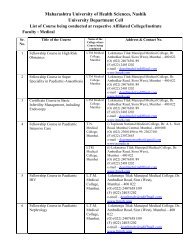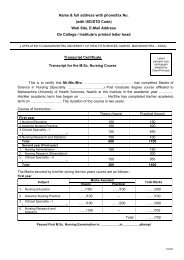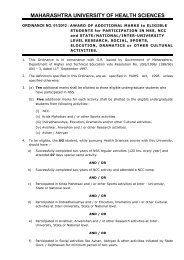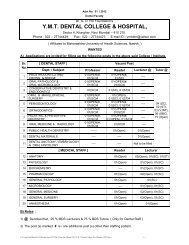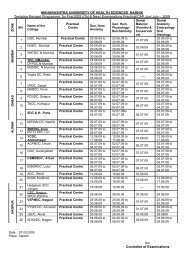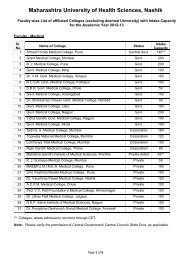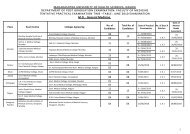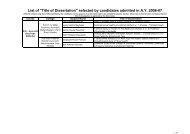Unit I
Unit I
Unit I
You also want an ePaper? Increase the reach of your titles
YUMPU automatically turns print PDFs into web optimized ePapers that Google loves.
Salivary glands: There are 3 pairs of major salivary glands and many small (minor) scattered salivaryglands. The saliva is a mixed secretion of the salivary glands. Depending upon the type of secretion unitsalivary glands are either serous, mucous or mixed type.The capsule of collagenous connective tissuecovers the gland. This collagenous capsule sends septa or partitions inside the gland which carry the bloodvessels and nerves and support the duct system. They also divide the gland substance into many lobules.The connective tissue is divided into interlobular and intralobular. Interlobular connective tissue is easilyseen in the form of septa containing blood vessels and ducts. Intralobular connective tissue is scanty,indistinct, and is present in the interalveolar areas. At places adipose tissue is present within the connectivetissue and inside the lobules.Serous salivary gland: Secretion is watery and is rich in digestive enzymes. The transverse section of thegland resembles a pie cut in to pieces but not yet served. Each piece of the pie corresponds to a singlesecretory cell.e.g Parotid salivary gland.The parotid gland is a compound tubuloalveolar or racemose gland. Leading from the secretory endpiecesare intercalated, striated and excretory ducts. All the excretory ducts finally open into the main parotidduct. Within each lobule are masses of serous alveoli is lined by the pyramidal simple columnar cells. Thelumen of the alveoli is scarcely seen. The nucleus are prominent and rounded. Serous alveoli show basalbasophilia and apical eosinophilic cytoplasm. The intralobular ducts, blood vessels and adipose tissue arealso seen within the lobule.Serous alveolus (H.P): Large triangular columnar cells rest on a basement membrane. A small lumen ispresent in the centre of each acinus but the lumen is difficult to see under L/M. The cytoplasm of the basalaspect of the cell is basophilic as it is rich in rER. The apical cytoplasm contains eosinophilic zymogengranules which are membrane bound vesicles containing secretion. The nucleus of myoepithelial cell is seenaround each alveolus.Intercalated duct: They are lined by cuboidal to simple squamous epithelium with prominent nuclei. Cellscontain long mitochondria,small rough endoplasmic reticulum, golgi apparatus, lysosomes and secretorygranules. It is involved in the addition of water and electrolytes to saliva. Lumen of the duct is small.Striated duct: Cells show basal striations due to packed columns of elongated mitochondria. Between thecolumns, the cytoplasm is divided into basal processes by infolded basal plasmalemma, lateral aspect ofwhich may be extensively plicated to interdigitate with the adjacent processes. These cells are engaged intransport of K+ into the saliva and Na + from saliva, thus make saliva hypotonic. The luminal surface formsmicrovilli. The duct lining is simple cuboidal to columnar cells with central nuclei. The lumen of duct isdistinct.Intralobular duct: All striated and intercalated ducts are intralobular ducts as they are seen only inside alobule and never in the interlobular tissue. Large number of these ducts and their prominent appearance isthe feature by which parotid can be differentiated from pancreas. All these ducts are distinctly seen scatteredwithin a lobule and surrounded by many secretory alveoli.Interlobular duct: The interlobular duct is seen within the interlobular tissue along with blood vessels. Theyare cut in all possible planes and seen accordingly in the slide. The lumen becomes progressively wider andthe lining epithelium is simple columnar and as the duct becomes wider it is lined by pseudostratifiedcolumnar nonciliated epithelium. The larger ducts are lined by stratified columnar epithelium.57



